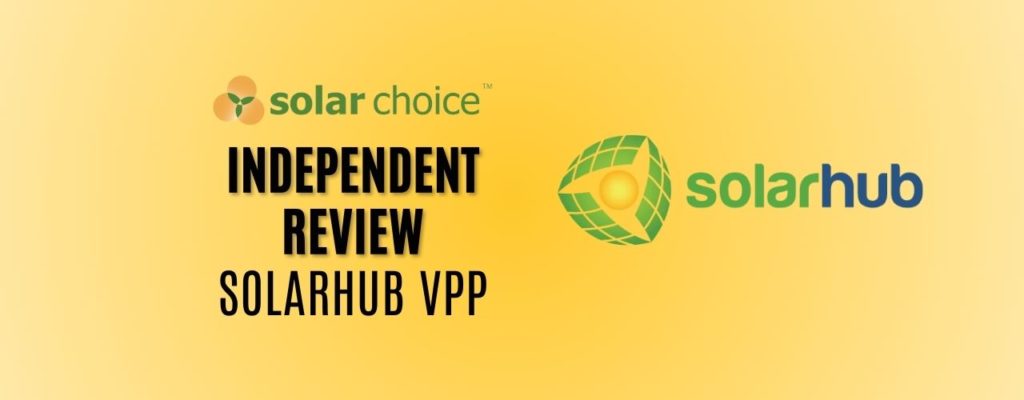Note: Solar Choice has no incentive to promote one VPP program over another. This review is designed to educate homeowners with unbiased, fact-based information.
VPP Overview
- Company behind it: SolarHub, a Canberra-based solar and battery installer. The VPP operates in partnership with ActewAGL.
- Other parties/partnerships: Supported by the NSW Government Emerging Energy Program, which awarded a $5.4m grant in 2020 to roll out the project.
- Commencement: Launched in 2020, with staged rollout through 2025.
- Scale: Target size of 6 MW (~650 customers). As of January 2025, around 4.2 MW had been installed, with full completion expected mid-2025.
- Geographical availability: Available to households in the ACT and nearby NSW council regions: Shoalhaven, Eurobodalla, Bega Valley, Queanbeyan-Palerang, Yass Valley (within 100 km of Canberra CBD), Snowy Monaro (within 100 km), and Goulburn Mulwaree.
For background, see: What is a Virtual Power Plant? and Is a VPP Worth It?.
Financial Benefits Offered
- Upfront discounts (historical): Under the NSW Smart Distributed Batteries project, households could access up to $4,950 off a Tesla Powerwall 2 when joining the VPP.
- Current incentives: Today, homeowners may instead benefit from the new Federal Battery Rebate (worth up to $4,500 for a 13.5 kWh battery) and in some cases additional NSW support.
- Ongoing compensation: Participants receive ActewAGL bill credits when their battery is dispatched to support the grid. These credits are applied directly to electricity bills and are not paid as cash. The amount is defined in your individual contract (not published as a flat $/kWh rate).
Savings example with a 15 kWh battery:
- High-use household: Could save ~$1,200/year by maximising solar self-consumption and benefiting from VPP bill credits.
- Low-use household: Might save ~$600/year, depending on usage patterns and tariffs.
For context on battery economics, see: Is Home Battery Storage Worth It? and our Solar Battery Guide.
Electricity Tariff / Rates
To participate, customers must switch to an ActewAGL retail electricity plan (e.g., Battery Saver or Solar Partner Plus). ActewAGL promotes lower daily supply charges and higher feed-in tariffs on these plans, but exact rates vary by region.
Compare electricity plans here:
- Electricity comparison overview
- NSW comparison
- VIC comparison
- QLD comparison
- Cheapest electricity providers
ActewAGL Live Electricity Rates
Battery and System Requirements
- Compatible batteries: Tesla Powerwall 2 or Powerwall 3; SolarEdge/LG Chem HV.
- Inverter: AC-coupled via Powerwall’s built-in inverter, or SolarEdge inverter with LG Chem HV.
- Connectivity: Continuous internet required via ethernet or Wi-Fi. 4G/5G SIM connections are not accepted as the primary method.
- Smart meter: Required for monitoring and dispatch.
See: Compare Solar Batteries and Battery Product Reviews.
Contract Length and Exit Terms
- Term: Standard VPP agreement runs for 12 months initially, then renews automatically year by year.
- Exit conditions: After the first year, participants can leave with 30 days’ notice. At renewal points, only 14 days’ notice is required.
- Rebate-linked installs: Customers who took upfront discounts (e.g., NSW rebates) may face additional participation obligations or repayment of part of the rebate if leaving early. Always confirm your contract terms in writing.
Technical Operations
- Control rights: ActewAGL can remotely charge, discharge, or hold your battery to help stabilise the grid.
- Limits: No public cap on how many times per year your battery may be used. Credits apply as set out in your individual contract.
- Backup reserve: The VPP will not discharge below 20% state of charge, protecting a portion of capacity for blackout backup.
- Testing: A commissioning test is required to ensure the system responds correctly before being fully enrolled.
Customer Experience
- Apps and monitoring: Customers continue to use their Tesla or SolarEdge apps to monitor performance, alongside standard ActewAGL billing tools. There is no separate VPP app.
- Transparency: Bill credits and participation are outlined in contracts, but households may not see detailed dispatch-event breakdowns.
- Support: Provided jointly by SolarHub (installation) and ActewAGL (retail plan and VPP operations).
Pros and Cons
Pros:
- Backed by NSW Government and a known local installer.
- Strong upfront discounts historically; federal rebate may still apply.
- Tesla Powerwall includes blackout protection, with 20% minimum reserve.
Cons:
- Must switch to an ActewAGL retail plan (reduced retailer choice).
- Credits are bill-only, not cash.
- Compatible with limited battery brands (Tesla and SolarEdge/LG Chem).
- Connectivity requirements exclude 4G-only households.
Is the SolarHub VPP Worth It?
For homeowners in the ACT and surrounding NSW councils who already own or plan to install a Tesla Powerwall or SolarEdge/LG Chem battery, the SolarHub VPP is a practical way to combine government rebates with ongoing bill credits. The main trade-offs are retailer lock-in and less transparency compared to some other VPPs.
Before deciding, compare with alternatives such as AGL VPP, Origin Loop, Amber SmartShift, and others in our VPP Comparison Guide.
How to Join
- Confirm you live in the ACT or eligible NSW council areas.
- Ensure you have a compatible battery (Tesla Powerwall 2/3 or SolarEdge/LG Chem HV).
- Review the ActewAGL VPP Services Agreement carefully (contract terms, exit rules, and credit structure).
- Compare ActewAGL tariffs against other retailers using our electricity comparison tools.
- Apply via SolarHub/ActewAGL once satisfied with the terms.
Overview
Availability
SolarHub’s Virtual Power Plant (VPP) program is currently offered in ACT and nearby NSW council regions (Shoalhaven, Eurobodalla, Bega Valley, Queanbeyan-Palerang, Yass Valley, Snowy Monaro, and Goulburn Mulwaree).
Battery Compatibility
The program supports a range of widely used battery brands, including: LG Chem and Tesla. SolarHub-installed systems only—no BYO.
Contract Terms
SolarHub’s VPP has a lock-in contract. Initial term is 12 months (renews automatically). You can leave with 30 days’ notice after the first year.
- Changes To Cheaper Home Batteries Program | Homeowners Guide | Coming 1 May 2026 - 15 December, 2025
- ReadySteadyPlug EV Charging for Apartments: An Independent Review by Solar Choice - 12 December, 2025
- Everything Electric Melbourne | EV Battery Health, Street Charging & Smarter Homes - 27 November, 2025
